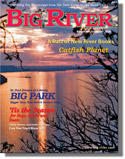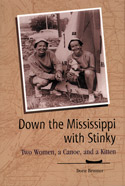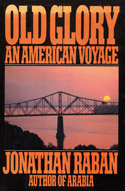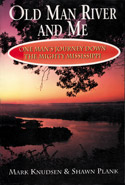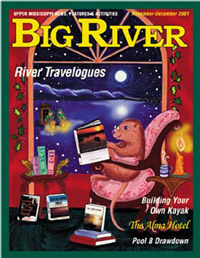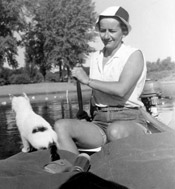|
Mississippi River Travelogues
|
Upper Mississippi Stories from Big River Magazine
|
||||
|
By Curt Leitz
|
|||||
|
Each November, we review several recent books about the river. This article and the accompanying bibliography, published in 2001, give an overview of earlier river travelogues. Subscribe now to read the latest Mississippi River book reviews, or purchase a single copy online or at your nearest bookstore.
Nearly everyone seeks transcendental union with nature, and nearly everyone discovers the river's sheer impersonal power.
Raban's dystopic vision results from the fact that he took the trip because he couldn't sleep without tranquilizers, couldn't write and had "lost whatever reserves of moral capital are needed for city life."
"We went to the river thinking it was a magnanimous old war horse, something akin to a god. And it wasn't. It was a troubled star. The journey led from brightness down through the heart of a new kind of darkness and into the evil pits of a dead zone." -- Big Muddy: Down the Mississippi Through America's Heartland
|

The best-known, best-loved and most influential travelogue is, of course, Mark Twain's Life on the Mississippi. Literary critics often frown on the book's untidy structure, combining folk legend, personal experience, scientific discourse and social satire in a form reminiscent of that other great 19th-century novel of the waters, Moby Dick. Twain's homage may be most significant as evidence of the mythical place the Mississippi River had already assumed, in Europe and the United States, by the late 19th century. This obsession is recorded in dozens of antebellum travelers' accounts, but it really took the gradual burial of the steamboat beneath steel rails to romanticize "old times on the Mississippi" sufficiently to create a cottage industry in river travelogues. By the 1920s, navigating the entire river, or at least from the Twin Cities to New Orleans, was common enough that several major publishing houses brought out books on the trip. Since then the pace has only increased, with at least two dozen full-length books treating the topic. Nearly everyone refers to Mark Twain, imagining themselves as modern-day Hucks. Nearly everyone seeks transcendental union with nature, and nearly everyone discovers the river's sheer impersonal power. Added together, these similarities outline our common assumptions about not only the Mississippi, but also progress, civilization and the complex relationship between nature and culture. The differences among these travelogues are just as interesting. One traveler meets droves of river rats working and playing on the river, while the next meets people cowering behind levees, fearing the next flood. One sees wide expanses of unspoiled nature, while another sees rampant environmental degradation. Where one finds lively river towns celebrating their place on the banks of America's greatest river, another finds crumbling communities that have forgotten the river that built them. These differences reflect the preconceptions, priorities and personal histories of those who travel the river, and while they provide much of a book's entertainment value, they also make selecting the right travelogue as important to a cozy winter's night as hot cocoa and a down comforter. Black Bras & Saturday Night Specials The Working River This ethos reaches its apex in Willard Price's The Amazing Mississippi (New York: John Day Co., 1962. 188 pp.), a shameless paean to the military-industrial complex. Today's reader -- post-Cold War, post-Silent Spring, and post-Kyoto -- will find Price's work either infuriating or quaintly obsolete, but as a cultural document his book records the concept of the industrial river that was nearly the consensus in the 1950s. Heart of Darkness No article on river reading would be complete without discussing Jonathon Raban's Old Glory (New York: Simon and Schuster, 1981. 409 pp.), which is the travelogue both most frequently begun and most seldom finished. The author's psychosocial dysfunction (often euphemized as "English abrasiveness," but cited by Raban himself as a reason for embarking on the journey) drives most readers away, as he repeatedly makes sweeping condemnations of local culture based on the types he consorts with -- in mid-afternoon, mind you -- in every strip joint and dive bar he can find. Unfortunately, Raban is one of the most talented, sophisticated and ironical writers to travel the river since Twain, so it's difficult to completely write off his book as so much cultural arrogance made vehement by self-destructive neurosis. For a time on the lower river Raban's perception and eloquence come together to portray social complexities as few other writers can. On our stretch of the river, though, Raban is a gruff old crank. Consider his first encounter with the river of his boyhood dreams, at St. Anthony Falls in Minneapolis' milling district: "It was just a river. From where I stood, the far bank was no more than a couple of hundred yards away. Its color was much the same as that of my domestic Thames: a pale dun, like iced tea with a lot of mosquito larvae wriggling in the glass. I squatted moodily on a bleached rock, looking across at the dead smokestacks of a Victorian mill and listening to the rumble of a weir upstream. I lit a cigarette to frighten off the gnats buzzing in a thick cloud around my head, and flipped the empty pack into the river." Raban's dystopic vision results from the fact that he took the trip because he couldn't sleep without tranquilizers, couldn't write and had "lost whatever reserves of moral capital are needed for city life." Honeymoon Cruise These six books only hint at the range of travelogues devoted to the Mississippi River. Others approach the river as an escape from a troubled marriage; a long hitchhiking trip in cars, trucks and towboats; a cheap home between jobs; and a hedonistic post-college quest. Some focus on river rats, some on nonhuman wildlife. A few of the most original books have been self-published. While hard to find, these books can be real pearls if you have an interest in the topics they bring to the foreground, or the perspectives they bring to the river. Others would be better off in an eelpout party bonfire. If you can't find one of these books at your library (be sure to check for an interlibrary loan) or bookstore, check out antique stores in rivertowns. Most have used books, and many have special sections of river books. There are online sources as well that can locate out-of-print books. Pick up a book, give it 20 pages, and if its style and subject don't have you ready to throw a raft together yourself, put it down and find another. And when you do finally make good on that dream to float the whole river, write your own Mississippi saga! Copyright 2001 See also: Mississippi River Travelogue Bibliography by Curt Leitz (Big River, Nov/Dec 2001) |
||||
